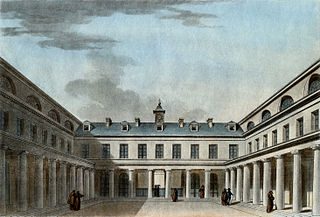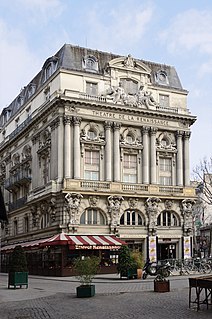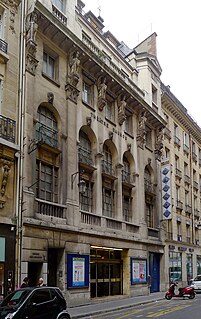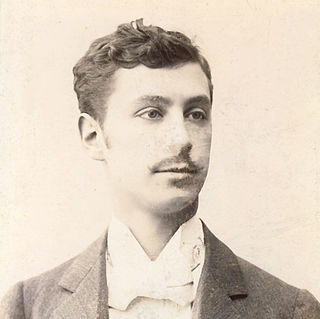
Boulevard theatre is a theatrical aesthetic that emerged from the boulevards of Paris' old city. [1] [2]

Boulevard theatre is a theatrical aesthetic that emerged from the boulevards of Paris' old city. [1] [2]
Starting from the second half of the 18th century, popular and bourgeois theatre alike took up residence on the boulevard du Temple, then nicknamed 'boulevard du Crime' due to the many melodramas and murder stories shown there. In addition to the many attractions on display there – fireworks, pantomime, acrobats, etc. – a so-called 'boulevard' repertoire emerged separate from upper-class theatre. Then, starting from the Second French Empire, vaudeville theatre and comédie d'intrigue arrived on the scene.
Boulevard theatre consists mostly of comedies but also dramas. In general, the characters are simply drawn, ordinary or easily understandable. There is a strong tendency to avoid touchy subjects, such as politics and religion. The style is not designed to challenge preconceived ideas or offend. Examples include such sex comedies as La Cage aux Folles and Boeing Boeing .
Georges Feydeau, most active between 1890 and 1920, often produced up to the 21st century, is a boulevard theatre playwright whose satiric plays often take aim at adulterers and libertines in a manner not generally seen in British theatre of the same era.

The Lycée Condorcet is a school founded in 1803 in Paris, France, located at 8, rue du Havre, in the city's 9th arrondissement. It is one of the four oldest high schools in Paris and also one of the most prestigious. Since its inception, various political eras have seen it given a number of different names, but its identity today honors the memory of the Marquis de Condorcet. The school provides secondary education as part of the French education system. Henri Bergson, Horace Finaly, Claude Lévi-Strauss, Marcel Proust, Francis Poulenc and Paul Verlaine are some of the students who attended the Lycée Condorcet.

The name Théâtre de la Renaissance has been used successively for three distinct Parisian theatre companies. The first two companies, which were short-lived enterprises in the 19th century, used the Salle Ventadour, now an office building on the Rue Méhul in the 2nd arrondissement.

Pierre-Eugène Veber was a French playwright and writer.
Jean Le Poulain was a French stage actor and stage director.

Gisèle Casadesus was a French actress, who appeared in numerous theatre and film productions. She was an honorary member of the Sociétaires of the Comédie-Française, Grand Officer of the Legion of Honor, Officer of the Ordre des Arts et des Lettres, and Grand-Croix of the National Order of Merit. In a career spanning more than 80 years, Casadesus appeared in more than a dozen films after turning 90.

The Théâtre Édouard VII, also called théâtre Édouard VII – Sacha Guitry, is located in Paris between the Madeleine and the Opéra Garnier in the 9th arrondissement. The square, in which there is a statue of King Edward the Seventh, was opened in 1911. The theatre, which was originally a cinema, was named in the honour of King Edward VII, as he was nicknamed the "most Parisian of all Kings", appreciative of French culture. In the early to mid 1900s,under the direction of Sacha Guitry, the theatre became a symbol of anglo-franco friendship, and where French people could discover and enjoy Anglo Saxon works. French actor and director Bernard Murat is the current director of the theatre. Modern "boulevard comedies" and vaudevilles are often performed there, and subtitled in English by the company Theatre in Paris. Important figures in the arts, cinema and theatre have performed there, including Orson Welles, Eartha Kitt, and more. Pablo Picasso created props for a play at the Théâtre Edouard VII in 1944.
Charles Dechamps was a French stage and film actor. He married the comedian Fernande Albany on 19 November 1925. He died in 1959, and was buried at cimetière du Père-Lachaise.

The théâtre Daunou is a Parisian theater with 450 seats, located at 7 rue Daunou in the 2nd arrondissement of Paris.
Alfred-Adolphe Pasquali was a French actor and theatre director.
Albert Rieux was a French stage and film actor.
Henry de Gorsse was a French writer, playwright, screenwriter and lyricist.
Robert Ancelin was a French actor and theater director. He was married with the soprano Fanély Revoil from 1937 to 1942 and directing manager of the Théâtre de la Porte-Saint-Martin from 1940 to 1949.
Denis d'Inès, real name Joseph-Victor-Octave Denis, was a French actor and theatre director for some plays. He entered the Comédie-Française in 1914, was a sociétaire from 1920 to 1953, and General administrator by intérim in 1945.

Maurice Hennequin was a French-naturalized Belgian playwright.
Jean-Paul Moulinot was a French actor, sociétaire of the Comédie-Française.

Ernest Henri Demanne was a French comedian.

The Théâtre de la Michodière is a theatre building and performing arts venue, located at 4 bis, rue de La Michodière in the 2nd arrondissement of Paris. Built by Auguste Bluysen in 1925 in Art Deco style, it has a tradition of showing boulevard theatre.